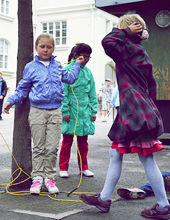
The Finnish school system might sound like a restless American schoolchild's daydream: school hours cut in half, little homework, no standardized tests, 50-minute recess and free lunch. But the Finns' unconventional approach to education has vaulted Finland to the upper echelon of countries in overall academic performance, according to the Organisation for Economic Co-operation and Development.
Finnish students have ranked at or near the top of the Program for International Student Assessment ever since testing started in 2000. In the most recent assessment in 2009, they ranked sixth in math, second in science and third in reading. By comparison, U.S. students ranked 30th, 23rd and 17th, respectively, of the 65 tested countries/economies.
But Finland's system hasn't always been successful.
"Finland had been traditionally thought of as the lowest achieving country in Scandinavia, and one of the lower achieving ones in Europe for a very long time. It was not a highly developed education system," said Linda Darling-Hammond, the co-director of the Stanford Center for Opportunity Policy in Education, in a lecture delivered Tuesday afternoon about the Finnish educational success story. She introduced the main speaker, Pasi Sahlberg, a Finnish education expert and the director of the Center for International Mobility and Cooperation in Finland's Ministry of Education and Culture.
From worst to first
"We came from behind from everybody else," Sahlberg said. "At some point in the last 40 years we've been able to pass the others."
In the last decades, U.S. and Finnish education policies have appeared to be moving in opposite directions. While U.S. public schools moved to standardized testing, Finnish schools eschewed nationwide tests to evaluate teachers, students or schools, instead relying on sample-based testing and school principals to identify potential problems, Sahlberg said.
While U.S. public schools are locally funded, usually from property taxes, and rewarded based on high performance through programs such as the U.S. Department of Education's Race to the Top grants, Finnish schools are nationally funded based on the number of students. Schools are provided additional funding if they have a higher proportion of immigrants or students whose parents are uneducated or unemployed, he said.
Darling-Hammond, who wrote about the Finnish educational system in her book The Flat World and Education: How America's Commitment to Equity Will Determine Our Future, also contrasted America's test-based teaching to Finland's more flexible system.
"The [Finnish] curricula are very much focused on critical thinking and problem solving, project-based learning, and learning to learn," she said. "There is a lot of collaboration in the classroom."
In his lecture, Sahlberg discussed three key areas: equality in education, time management and perception of teachers as professionals, topics also covered in his recent book, Finnish Lessons: What Can the World Learn from Educational Change in Finland?
Lower cost, better results
"We are spending less money than average for developed countries, much less than the United States. We spend less time, but the learning achievements are high," Sahlberg said. "You put more money and more time there, but the outcome, the achievements are less.
"When we compare teachers to other professions in society, we compare them to lawyers or doctors or architects," he said. "Not as here [in the United States], where they are compared to nurses or therapists, or something like that, that require lower academic training."
Teachers in Finland are required to obtain a three-year master's degree, state-funded, before teaching. These education positions are highly coveted, Sahlberg said. For example, only one in 10 primary-school teacher applicants are accepted.
"It's harder to get into primary school education than a medical program," he said.
But Sahlberg identified the biggest obstacle in the U.S. system as the same policy intended to revolutionize education. "If I could change one thing in policy, I would seriously rethink the role of standardized testing," he said in an interview with the Stanford News Service. "No high-performing nation in the world has been successful using the policies that the United States is using."
Sahlberg said that he doesn't think standardized testing is inherently bad, but "the way it's done here is simply leading to so many negative consequences, in the form of narrowing curricula and reshaping the way teachers and schools are working."
Sahlberg is quick to point out that solutions won't be as easy as transplanting Finland's policies across the Atlantic.
"I'm not trying to convince people that if they follow what Finland is doing, things will be good. All the education issues and reforms are done specifically to the culture and should be done locally," he said. "I'm very much aware that America is very different culturally. I'm trying to tell what we've been doing and use Finland as real-world evidence."
Ironically, inspiration for many of Finland's changes came from research in the United States, which contributes 80 percent of the world's education research, by Sahlberg's estimation. "We've built this excellent, high-performing, equitable system that everyone is praising today, based on American innovations," he said.

